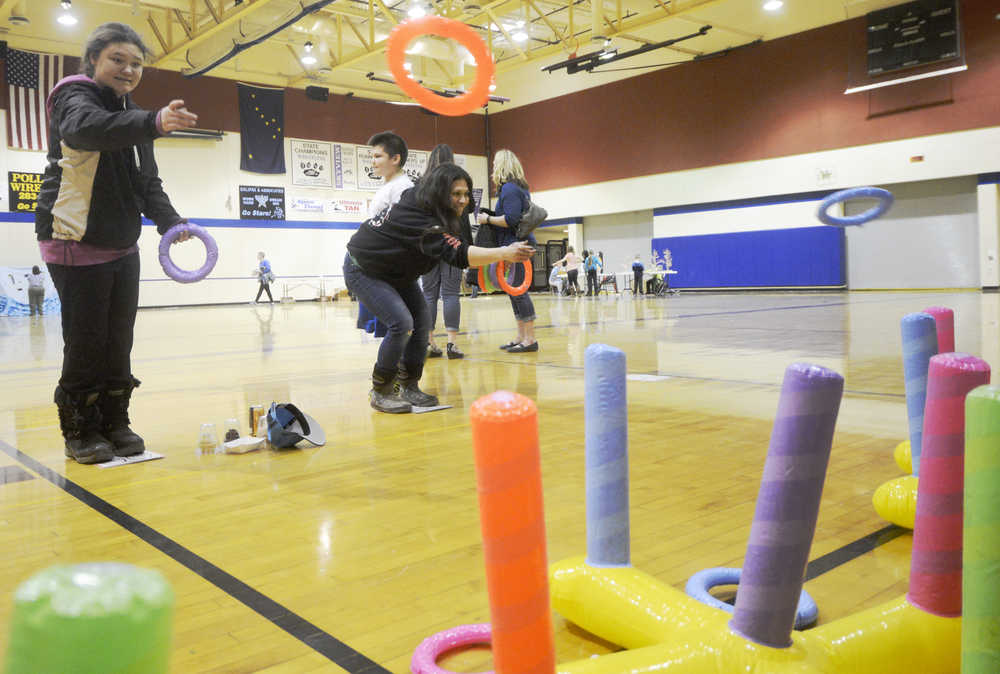At stations scattered through the two gymnasiums of Soldotna Preparatory School, children with autism played a ring-toss game, won cupcakes in a circle of musical chairs, walked on bucket stilts and crawled through a network of tents and fabric tunnels.
Their parents, meanwhile, spoke to representatives of care services such as Hope Community Resources, Frontier Community Services, Central Peninsula Health Services and therapists and special educators from the Kenai Peninsula Borough School District during this year’s Autism Extravaganza.
“Basically my idea behind this is to get all the care providers, service providers, people that serve special needs — not necessarily autism, but special needs — in one spot, so that people can come here and find what we have on the peninsula,” said Jerri Braun, a board member of the Autism Society of Alaska and organizer of the event, held for the third time Saturday at the school. “We offer the games for the kids to have something to do while parents are talking to the providers about what’s going on.”
The event also raised funds from tickets, food sales and a silent auction, to be put toward hiring speakers on autism to lecture on the peninsula.
Braun said her son and grandson both have autism, though her son is undiagnosed. Braun said that when her son was young, she had been confused by his condition and the diagnosis it received.
“They called it cognitive thinking disorder,” she said. “To me, it made no sense … If they had told me autism, I probably would have fought it, but I would have learned more about it, and probably instigated more things toward it … And I probably would have fought harder for him.”
The way people understand and react to autism is changin — April is Autism Awareness month, and the colorful puzzle-piece that serves as a popular symbol of the condition is widely recognized and displayed — Braun said the peninsula likely has several cases of undiagnosed autism, including “some that do not want to be diagnosed.”
“They know they’re on the spectrum somewhere, but they don’t want that label, because they perceive it as a hindrance,” Braun said. “To me, the label is just that, it’s a label. It gives you ideas of where to go … Once you have the diagnosis, it puts relief in your mind. As parents, when you first get that diagnosis, it’s not a relief. It is total stress, depression, just overwhelming ‘what am I going to do with my life?’ … But the earlier you can get diagnosed, the earlier they can help you start learning how to deal with the child, and the child to deal with his surroundings.”
Occupational therapist Susan Matthews of Kenai Kids Therapy said she believes most cases of autism on the peninsula are diagnosed, but the age of diagnosis makes a big difference.
“Some kids we see when they’re young, and we can do some early intervention to help promote their development,” Matthews said. “Kids we see later have probably not gotten too many services. There are neural windows when you can make changes in brain development when kids are young.”
These windows usually occur between ages 5 and 9, Matthews said.
“And after that the brain’s pretty solid as it is,” Matthews said. “Then you work on compensations, techniques to deal with the brain and the world, so that they have good skills.”
Missed opportunities for therapy early in life can create difficulty later in life, Matthews said.
“It makes it harder on kids because they don’t learn the social skills, they don’t learn to regulate their own body, their responses to things,” she said. “It just makes it all the more difficult to live in a normal world of the grocery store that gets crazy at five o’clock.”
The environment at Soldotna Preparatory School during the fair did not resemble that overwhelming grocery store. The game and information stations were widely spaced through out the gym, providing room for children to shift their focus between activities — a task that can be difficult for children with autism, according to Kenai Peninsula School District Special Education Program Coordinator Elizabeth Falk.
The level of noise and activity in the environment was moderate — enough to excite, but not enough to overstimulate. Although no station attendants said they had chosen their games to provide particular benefits to autistic children, some emphasized the simple value of action and socialization.
“These are just things kids like to do,” said Matt Jager, a school district occupational therapist manning the inflatable ring-toss game. “It’s not necessarily specific to autistic kids. I’d say a big part of this is that you’re trying to get kids into a community environment … (There are) challenges of reading people and being in proximity to a lot of other people. Trying to give them fun things to do that allow them to be with other people is social integration.”
Reach Ben Boettger at ben.boettger@peninsulaclarion.com.

